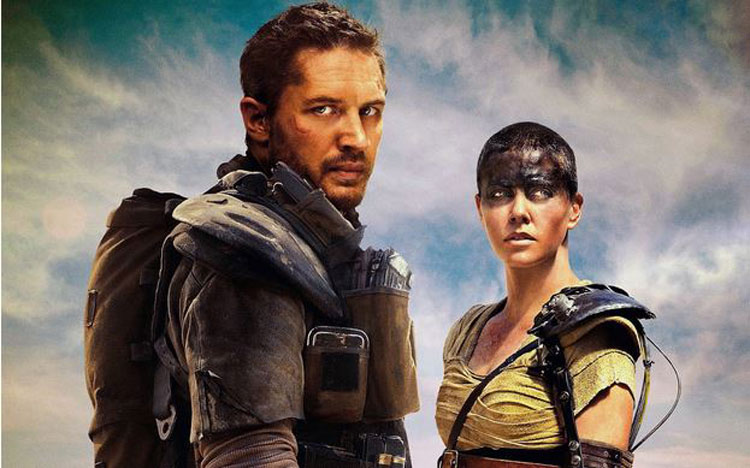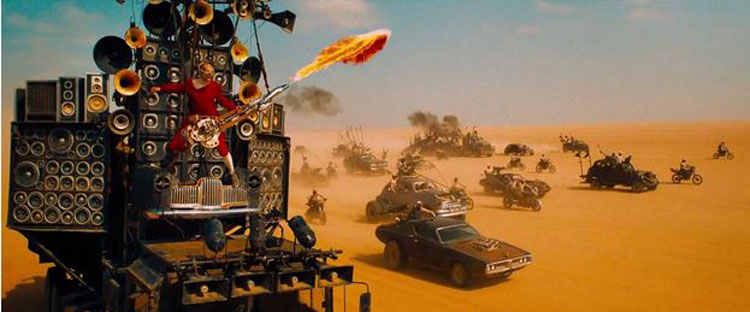Mad Max Fury Road is a brilliant and compelling resurrection of the post-apocalyptic Mad Max universe, with director George Miller returning from an almost 30 year hiatus from the franchise. The film has been met with critical acclaim from movie critics and fans alike, and enormous disdain from whiny pissbabies who hate women, both of which are reason enough for me to see almost any movie. This combined with the promise of little dialogue, no romantic subplots, at least one explosion per five minute time frame, kickass female characters, the takedown of a fascist, cult-like regime, and a character whose entire job is to play guitar riffs while dangling off bungee cords in the front of a truck that looks like a medieval pipe organ had me sold. Say no more. That’s fucking awesome.
The fourth installment of the series, which has already been praised as the best reviewed film of 2015, opens on a stark desert landscape where water and gasoline are scarce commodities and civilization as we know it had collapsed 45 years prior. Max is captured by a group of War Boys under the command of a cult leader warlord named Joe and taken to a fortified canyon where he is caged and used as a ‘blood bag’ for a sickly warboy named Nux. Furiosa, a woman who has risen through the ranks since being captured and taken from her homeland as a child, is sent to collect gasoline in a massive War Rig, but begins driving off course shortly after starting her journey. Joe is then alerted that his 5 wives, the only pristine, childbearing women in the society, tasked with bearing his progeny, have run away in hopes of finding the matriarchal ‘Green Place’ that Furiosa used to call home.
Joe leads his devoted War Boy army to pursue his prized breeders, with aid from nearby Gastown and Bullet Farm. Max, through almost impossible happenstance and an explosion or two joins Furiosa in her fight for survival and redemption as they make their way to what they hope will be a safer, greener place.
After “Craptain Crapitalism” had the nerve to write a piece of content so whiny, ignorant, and blatantly sexist about the “feminist propaganda” present in Mad Max: Fury Road, I was just as eager as the rest of the populace to not only burn him alive, but to champion MM:FR as the feminist movie of the century. It is clear after watching the film, however, that the literal translation of Captain Capitalism’s favorite phrase, “feminist propaganda” might be more appropriately described as “movie that cast women.”
There have been hundreds of pieces written since MM:FR’s release praising it for being a feminist masterpiece. While I would love nothing more to agree with them, and give Mad Max the feminist green light, I’m hesitant to do so. Many of these reviewers have fallen into the Bechdel Test trap, buying into the idea that just because women are in a movie, that movie should be heralded as a feminist masterpiece. Don’t get me wrong, Furiosa is easily one of the most well written, kick ass characters that I have seen in a long time. She is the definition of a strong female lead, and without a doubt overshadows the namesake of the film. But having ONE strong female lead in a multi-million dollar blockbuster film is no longer enough to carry a movie to feminist Valhalla. We have to start expecting more. ONE believable, fully fleshed out female character is the bare minimum.
But since there is already plenty of debate surrounding the social commentary of this film, I will lay my feminist head to rest and go back to the basics and look at the storytelling and the technicality of Mad Max: Fury Road.
George Miller’s storytelling throughout Fury Road is simple and masterful. He has taken his original concept of a generic wasteland and expanded it into a richly engrossing world full of different cultures and religions, and it never feels forced. He uses a simple and subtle technique to engage us and educate us, by making the viewer think they are Max. Max is more of an accompaniment piece to this visual opera of a film, a vessel through which we see the story. This technique gives the viewer the chance to experience this world first hand, like they have been thrown into this chaotic world, only to take in bits and pieces as we slowly and organically start to pick up on the way the world works.
Take, for instance, the influence of religion on the War Boys. The film never flat-out tells us that they have been influenced by various religions of yore, but through smart and purposeful dialogue/events we start to realize that these boys have taken key parts of a number of religious and indigenous belief systems that have been passed down by word-of-mouth for some period of time. As a viewer, you start to understand how these people took bits and pieces of Norse mythology, Christian theology, and even tribal beliefs to get to the point where they are currently in their timeline, while also taking into account the world in which they currently live. These people only have a few things; water, desert, metal music and, most importantly, old rusted up pieces of junk for cars. So what is their version of a heaven? A heaven made fully of chrome. A place where every car is perfect and so are their bodies, and the reason this doesn’t come across as forced or hollow is because this is all they know.
All of this comes unpretentiously together with one key factor; the timing. This entire film is essentially a two-hour long chase scene with brief moments to catch your breath in between all of the mayhem and chaos. But it’s the brief moments of peace where we have time to reflect and take-in everything we’ve been experiencing and the subtle cues of the mythos of this wasteland. And it works.









